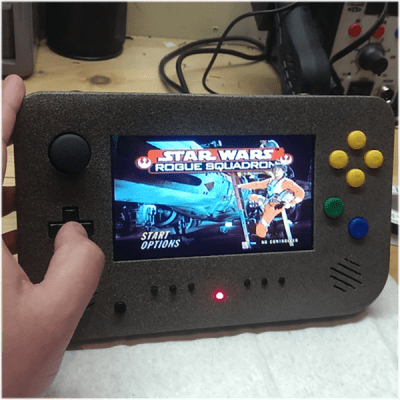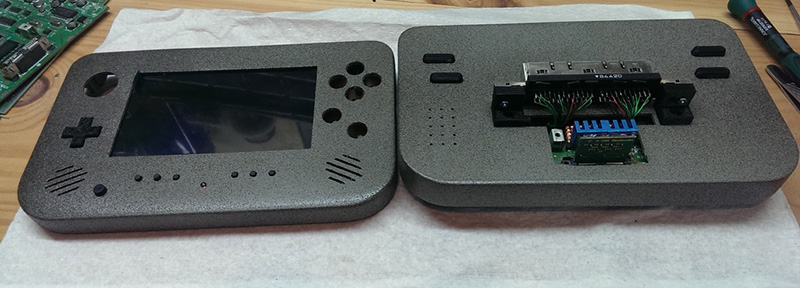With dozens of powerful single board Linux computers available, you would think the time-tested practice of turning vintage video game consoles would be a lost art. Emulators are available for everything, and these tiny Linux boxes are smaller than the original circuitry found in these old consoles. [Chris], one of the best console modders out there, is still pumping out projects. His latest is a portable N64, and it’s exactly what we’ve come to expect from one of the trade’s masters.
We’ve seen dozens of Nintendo 64s modded into battery-powered handhelds over the years, and [Chris]’ latest project follows the familiar format: remove the PCB from the console, add a screen, some buttons, and a battery, and wrap everything up in a nice case. It’s the last part of the build – the case – that is interesting here. The case was fabricated using a combination of 3D printing CNC machining.
 The enclosure for this project was initially printed in PLA, the parts glued together and finally filled for a nice, smooth finish. [Chris] says PLA was a bad choice – the low melting point means the heat from milling the face plate gums up the piece. In the future, he’ll still be using printed parts for enclosures, but for precision work he’ll move over to milling polystyrene sheets.
The enclosure for this project was initially printed in PLA, the parts glued together and finally filled for a nice, smooth finish. [Chris] says PLA was a bad choice – the low melting point means the heat from milling the face plate gums up the piece. In the future, he’ll still be using printed parts for enclosures, but for precision work he’ll move over to milling polystyrene sheets.
With the case completed, a few heat sinks were added to the biggest chips on the board, new button breakout board milled, and a custom audio amp laid out. The result is a beautifully crafted portable N64 that is far classier and more substantial than any emulator could ever pull off.
[Chris] put together a video walkthrough of his build. You can check that out below.
















dude that is awesome man i like it a lot i wish i had a frame like that i would build my own and the rounded edge part doesn’t look bad actually looks good gives it some curve detail you know. i do have a N64 system i still play matter a fact. Do you have these frames for sale if so i would so buy one.:)
looked great til i saw the back. would have been much better with a gameboy style cartridge slot
the unpainted part on the left bottom is the slot / expansion cover:
http://i862.photobucket.com/albums/ab182/cndowning/Northman%20N64p/IMAG1719_zpspuezebjp.jpg
Console emulator’s overdone but this is something else. Looks like a commercial product. great hack
if commercial products tended to have exposed PCBs and point to point wiring
I meant from the front.
There is a shield for the exposed bits on the back, geez…
So unfortunate to see so projects of this sort failing to use a monitor with the correct aspect ratio. N64 in widescreen?
I feel you. But on the other hand, these days 4:3 LCDs have become something you need to spend some time hunting down, and a lot of people seem to simply not care. I dunno, maybe something wrong with their eyes?
Hey, at least it’s not vertical.
Why do so many of these portable consoles use widescreen monitors? It seems like a great deal of work to put into a project with such a fatal flaw.
If I had to guess, it would be because they are cheaper and more widely available than 4:3 LCDs.
Much cheaper. 4:3 by default is a rarity for any modern application and to get one specifically is almost $30 to $40 more each. However, the one I used has the option of 4:3 however it does shrink the screen size to about 3.5″. But again, with a screen this small, the stretch issues really are not a huge detriment to the system.
If you plan to play Jet Force Gemini, it would be just fine, since it supports wide-screen. I haven’t played very many N64 games, but there are probably others with 16:9 modes out there.
To add on to that, according to wikipedia “A number of games also support a video display ratio of up to 16:9 using either anamorphic widescreen or letterboxing. However, very few games provide options to use this feature, such as these: Banjo-Tooie, Donkey Kong 64, GoldenEye 007, The World Is Not Enough, Jet Force Gemini, Perfect Dark, Starshot: Space Circus Fever, Turok 2: Seeds of Evil, Turok 3: Shadow of Oblivion, Mission Impossible, and South Park”
I keep going back and forth for years on a project to do this with a Commodore 64. Obviously a C64 motherboard is just huge. So it would need a new board designed. What the plan would be is to keep as much of the original custom chips in there. But then I think, the biggest appeal of the C64 is really just the SID and VIC. So, not keep those and emulate the rest with an FPGA? And then the other side of my brain tells that isn’t really original anymore…
And really you could probably keep all the original custom ICs and just use modern flash, RAM, and just use programmable logic for all the glue logic that takes up the majority of the board.
And then I argue that really emulation of the C64 is actually really good now and ARM boards are cheap, small, and low power. But there are already a ton of things like that out there, so what would be the point.
Sigh. Maybe someday when both sides of my brain stop arguing and choose a direction to go, I might set about doing it.
Would anybody actually be interested in seeing that?
If you want a smaller C64, you could mod one of the plug and play C64 DTV consoles http://www.chrismcovell.com/c64dtv.html
I am aware of them and have several. I have put together a few projects with them. But they don’t have an original SID or VIC. It is emulated on an ASIC and buying them today is more more expensive than a Raspberry Pi which would be easier to work with and already has an SD port.
Very cool devices, but it’s not the real thing.
It’s not actually emulated, as in software on a more powerful processor, it’s all running in hard logic, I’d guess the digital bits are the same. I dunno how the analogue bits differ, and how Jeri managed the sound, but I’ve got one too and it plays pretty well.
I suppose with the advantage of more layers, you could squash the chips closer together on a custom PCB.
It is hardware emulated, correct. The audio and video are done using R2R ladders. Yeah, it plays well for the most part, but unless you also purchase an SD2IEC, you need to flash your games onto it each time.
There are actually schematics online for it if you are interested.
Someone is working on a C64 in a FPGA, with extensions…
http://c65gs.blogspot.com.au/
Nice project. I’ll have to follow that